antiterror13
Brigadier
I'm not sure why you aren't already banned yet, to be honest. That kind of talk on this kind of forum is about as flamebaiting as it gets.
he will ... Jeff will address that
I'm not sure why you aren't already banned yet, to be honest. That kind of talk on this kind of forum is about as flamebaiting as it gets.
he will ... Jeff will address that
TBCThe Marines are conducting a test that could drastically change how combat troops deploy
Gidget Fuentes, Special to Marine Corps Times1:44 p.m. EDT August 15, 2016
It was a big difference from a seven-day exercise Kilo Company participated in last year when they had to rely on aircraft to deliver water to a nearby landing zone. Kociuba said the Marines spent hours trekking to that spot to bring the water back to their base. It not only left them feeling hot, tired and thirsty, but also pulled them away from their combat mission.
"Having those vehicles ... and technologies has allowed us to fight,” Kociuba said.
Sending Marines into the desert midsummer to test those concepts didn't come without risk. While they didn't suffer heat casualties, Patterson said the experiment did lead to more casualties than he expected. If it was a real mission, “we would have been stressed at the casualty level,” he said.

High-tech fighting
Grunts already carry a lot, and adding things like water purifiers, energy harvesters and drones was going to prove problematic, said Capt. Mike Malandra, ground combat element branch head with the Warfighting Lab's science and technology division.
“They are probably overburdened, but we're trying to gather a lot of data in a limited amount of time,” he said.
The Kilo Marines embraced the new tech, though, which 2nd Lt. Eric Cybulski, first platoon commander, said helped his Marines to be more decisive in battle without requiring much from the company or battalion. While they were pretty overwhelmed at first, they quickly learned how to use the drones, unmanned vehicles and heavier weaponry to their advantage.
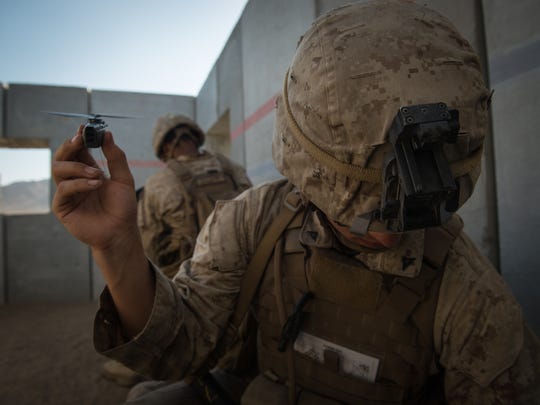
A member of Kilo Company prepares the newly developed Black Hornet unmanned aerial system for flight Aug. 5. (Photo: Lance Cpl. Julien Rodarte/Marine Corps)
They loaded up the vehicles with some of the gear. Kociuba liked the Multi-Utility Tactical Transport and small trailer in particular in order to carry heavy items. The Marines could also attach a .50-cal weapon, which gave the company extra standoff power they usually lack.
“The ability to not put a Marine in harm's way, you can't put a number on that,” he said.
Brig. Gen. Julian Alford, the Warfighting Lab’s commander, said the Corps just bought 144 of the diesel utility tactical vehicles, which he said are great for “the light infantry moving around.” The High-Efficiency Internally Transportable Trailer was also a hit. That vehicle includes a “green” energy hub to power and recharge batteries.
The Marines got similar benefits from a power-generating exoskeleton called the Joint Infantry Combat Prototype. The Army-designed product has a frame that slides up and down as a Marine walks or runs, which captures the energy. The item can be used with Marines’ existing packs and an additional waist pouch holds rechargeable batteries and other nodes that the grunts could use to charge their stuff. The item caught the commandant’s eye when he met with the Marines.
As for the drones, the Marines used a pair of MQ-9 Reaper unmanned aerial vehicles. One, which was owned and flown by General Atomics Aeronautical Systems Inc., provided aerial intelligence, surveillance and reconnaissance capability to Kilo Company and the headquarters element, working with joint terminal attack controllers with each platoon. A second Reaper, belonging to the 163rd Attack Wing of the California Air National Guard, was equipped with Hellfire missiles and bombs that were dropped during live-fire training in early August.
“The sensor capability the Reaper has is very good, even at the altitude it flies at, which is very high,” said Staff Sgt. Jon Traylor, one of three seasoned JTACs assigned to Kilo to work with aircraft and deconflict air traffic. The JTACs guided platoon leaders, who can see imagery and video on tablets, and worked with the flying crew to identify targets to find or further investigate.
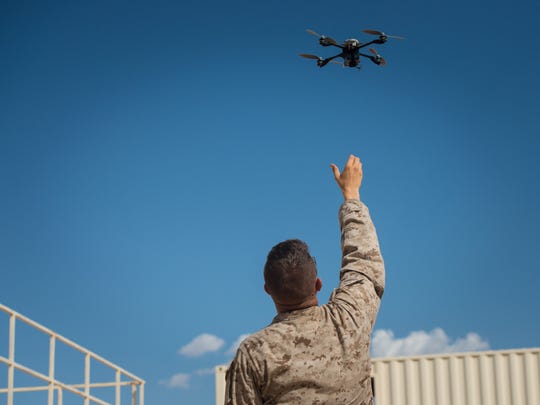
A Marine provides reconnaissance with an “Instant Eye” unmanned aerial system. (Photo: Lance Cpl. Julien Rodarte/Marine Corps)
During the exercise, Traylor spent most of his time working alongside the platoon commander, who in the experiment was “doing something that traditionally a company commander or a battalion operations officer would do,” he said.
Having the Reaper available to loiter long hours over an area and carry ordnance is a big deal for ground forces, which don't typically have access to such strategic assets to enhance situational awareness. While the Marine Corps doesn’t have any Reapers, Neller said he was impressed by the drones’ ISR and striking capabilities, adding that he thought “those are things … are going to be on our shopping list for sure.”
The Marines also tested small drones to find enemy forces and identify friendly positions when communications went down. Alford said the Warfighting Lab is on the hunt for drones that can take off and land vertically and operate from the sea.
“Right now, that technology is not there, but we're working toward it,” he said.
It’s technology that can’t come fast enough for Marines.
“Having the Reaper on station was the most important thing,” Patterson said as the field exercise wrapped up Aug. 3. He was impressed by the amount of situational awareness the aircraft provided, calling it “something that we need right now.”
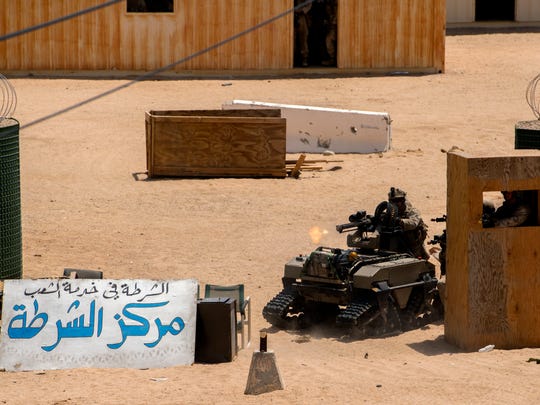
Marines fire the Weaponized Multi-Utility Tactical Transport Vehicle. (Photo: Cpl. Thor J. Larson/Marine Corps)
Marines also need strong weaponry, so officials are considering new armed autonomous vehicles. A remote gun — or robogun — would give a unit more firepower while risking fewer lives. It can also provide covering or suppressive fire.
The Kilo Marines also used the Modular Advanced Armed Robotic System, or MAARS, a small, tracked unmanned ground vehicle outfitted with an M240 machine gun and 40mm grenade launcher. They also tested the Robotic Vehicle Modular outfitted with a 7.62mm minigun.
The Marine Corps isn't about to field such devices just yet, but leaders are interested in collecting data on how they perform.
Revamping infantry units
Kilo Company, along with the rest of its battalion, will continue this experiment through the fall with an integrated training exercise here. They'll then move onto some pre-deployment workups before rotating to Okinawa, Japan.
The battalion will serve as the ground combat element for the 31st Marine Expeditionary Unit, which will embark with the Bonhomme Richard amphibious ready group and join in exercise “Talisman Sabre” in Australia next year.
While some of the lessons learned during this test could be applied to future exercises, like the next iteration of Bold Alligator, Alford said no final decisions on technologies, equipment or company structure have been made.
The hope is “it's not only going to make us communicate better and be able to move faster under less load, but just be more lethal. That's really what it comes down to,” Malandra said. “Now, how do you define or measure lethality?” The experimentation will help determine that.
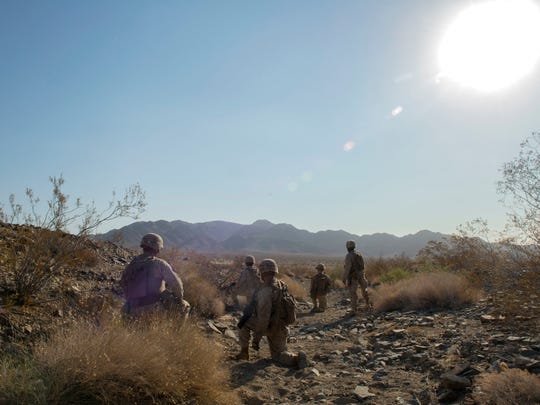
Marines run through a training scenario during the experiment that could shape the way Marines deploy in future operations. (Photo: Cpl. Thor Larson/Marine Corps)
As Marines face enemies around the world with increasingly lethal technologies, Malandra said it’s vital that the Corps develop concepts of operations and techniques that will give them the advantage.
“We're not just going to concede the technological advantage to the enemy because we're so set in our ways of using maps and boards,” he said. “We need to change something.”
But high-tech gear isn't the end-all. The Marine Corps is also looking at the makeup of platoons and squads, potentially adding new assistant squad leaders that could be responsible for flying drones and handling some of the gear.
“We can become way more effective as a platoon and we can take on more difficult tasks because we have this equipment,” Cybulski, the first platoon commander, said. “At the end of the day, a lot of it is going to save Marines' lives.”


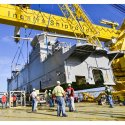
The U.S. Air Force (USAF) successfully tested the release of a Joint Air-to-Surface Standoff Missile (JASSM) from the internal weapons bay of a B-52H Stratofortress long-range heavy bomber, to a USAF press release.
The test involved the dropping of three Lockheed Martin AGM-158 JASSM stand-off cruise missiles–a new long-range, radar-evading cruise missile designed to destroy hostile air defenses before aircraft are within range—from the B-52′s internal bomb bay, fitted with an upgraded conventional rotary launcher.
It was the first time that a B-52 has successfully released a JASSM from its internal weapons bay. While the bomber already could carry up to 12 JASSMs on its wing pylons, the capability to carry eight more JASSMs inside the bomb bay will increase the bomber’s stand-off cruise missile payload by more than 60 percent. The B-52 was previously only capable of carrying unguided munitions—“dumb bombs’—in its internal weapons bay.
Another advantage of carrying the JASSMs inside the bomb bay is that it reduces drag, which increases fuel efficiency and extends the bomber’s range and mission time. “For long range operations, this means less drag. The aircraft can fly further and faster and still return to base after the mission,” said Jose Estrada a weapons integration engineer with the USAF’s 775th Test Squadron.
As I reported previously (See: ), the USAF’s B-52 bomber fleet will also be armed with the Joint Air-to-Surface Standoff Missile – Extended Range (JASSM-ER) by 2018. “Adding the extended range variant will more than double the bomber’s JASSM strike distance to 500 nautical miles (926 kilometers),” I explained.
Furthermore, I noted:
The new 2,000-pound conventional, air-to-ground, precision standoff missile is powered by the Williams International F107-WR-105 turbofan engine and armed with a penetrating blast-fragmentation warhead. The U.S. Air Force has approved full-rate production of the new missile in December 2014. Under an October 2015 contract Lockheed Martin will build 140 baseline JASSMs and 140 JASSM-ER missiles.
In July, a B-52 bomber also dropped from its internal weapons bay for the first time. The USAF is also working on integrating the ADM-160 MALD (Miniature Air-Launched Decoy) decoy with the B-52’s new digitized rotary launcher.
All of this is part of the USAF’s quest for a more affordable capability against burgeoning anti-access/area denial threats. The bomber aircraft should be capable of launching its JASSMs and JDAMs from outside of a defended airspace and the coverage of long-range surface-to-air missiles.
source:The Navy is considering expanding the number of SeaRAM installations on its ships beyond a quartet of ballistic missile defense ships based in Spain and Littoral Combat Ships, a service official told USNI News on Tuesday.
“Internally to the Navy there are trade studies going on to look at where to place SeaRAM on different ship classes,” Capt. Craig Bowden with Program Executive Office Integrated Warfare Systems said.
While no decisions have been made, the Office of the Chief of Naval Operations assessment arm (OPNAV 81) is in the midst of the look on which ships it could add the system designed to intercept and destroy incoming cruise and anti-ship missiles.
Officials with SeaRAM manufacturer Raytheon told reporters on Monday the company was in talks with the service to add the 11 missile system to additional guided missile destroyers beyond the Rota quartet.
The systems were earmarked for the Rota DDGs specifically to counter a Russian cruise missile threat that emerged in the Mediterranean region following Moscow’s seizure of Crimea and escalating tensions with the West, several service sources have told USNI News. Neither Raytheon nor Bowden would provide additional details on the threat.
While the Rota destroyers are equipped with the Aegis combat system designed to intercept air and cruise missile threats with its SM-2 missiles, the ships can’t use the system against traditional air threats while set to look for ballistic missile threats.
“We put [the ships] out there by themselves, and they’re putting all their radar energy up in space, they’re tracking space objects now, and you have to wonder, hey, can they defend themselves?,” .
The vulnerability prompted U.S. 6th Fleet and OPNAV to push for the installation of the SeaRAM on the Rota ships for an added layer of protection via an urgent operational request.
“Things heated up in the Eastern Mediterranean and suddenly there’s a capability… the adversary changed and became a bigger problem,” Rick McDonnell, Raytheon program directors for close-in weapon systems told reporters.
“Speed to deploy was going to be a big part of the issue.”
The Navy elected to replace one of two Phalanx close-in weapon systems on the DDGs with the SeaRAM system.
The two systems are 85 percent common and similar enough in weight not to prompt additional strengthening of the hull of the ships.
The addition creates an additional layer of defense for the destroyers between the long range of the SM-2s and the only mile or so range of the Phalanx’s gun, Bowden said.
“The Standard Missile is a great missile but it’s designed for threats that are farther away from the ship, They really didn’t have anything … for the 3 to 6 mile a defensive bubble around the ship,” he said.
In addition to BMD protection in Europe, the Navy also conducts BMD patrols with single destroyers in the Western Pacific with the same inherent vulnerability as the Rota destroyers.
While the service’s latest Baseline 9 Aegis system is able to track and intercept traditional air and ballistic missile defense targets at the same time, Raytheon officials said the Navy was considering including the systems on the newer ships.
The SeaRAMs are also fielded on the Independence-class LCS and will be included on the Lockheed Martin Freedom-class LCS starting with the LCS 17.
Good move.I would've preferred if there had been no "Studying" in Navy Studying Installing SeaRAM on More Destroyers, Other Ship Classes
source:
